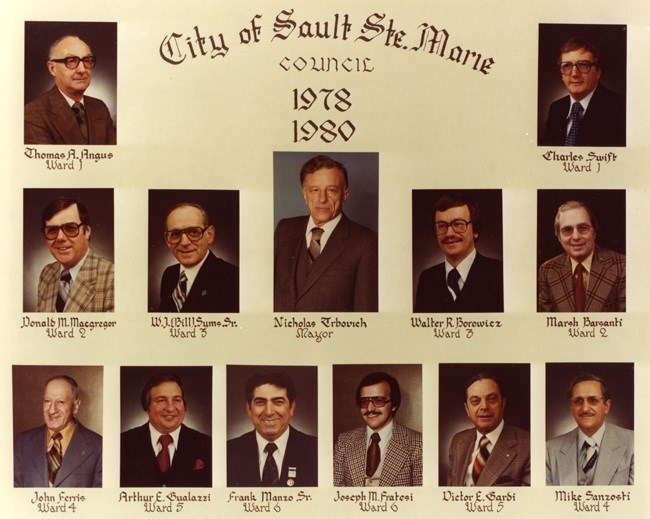From the archives of the Sault Ste. Marie Public Library:
*************************
Remember This?...John Ferris, labour leader
Perhaps no individual has shaped labour unions in Sault Ste. Marie history as much as John Ferris.
His “socialist” union ideology was something he definitely did not inherit from his parents, considering they held conservative views.
Born in Sault Ste. Marie, Michigan in 1910 he grew up in the west-end of Sault Ste. Marie, Ontario on James Street.
He attended McFadden Public School and completed Grade 8.
He then worked in his father’s dry goods store until the age of 18 when he left on a package freighter to sail the Great Lakes. It was during this time that he was exposed to the North American Labour movement.
He recalled being penniless and singing union songs in port-cities.
During the 1930s Ferris was labelled a “Bolshevik” for his union activities and was thrown in jail overnight on what he referred to as “trumped up” vagrancy charges.
John Ferris returned to Sault Ste. Marie in 1930 to help run the family store while his father was ill.
However, that type of work wasn’t for him. He also worked as a cub reporter at the Sault Daily Star.
During the time spent in his father’s store he met a number of union people.
Government relief had recently been established and much of the store’s income came from those relief cheques.
In 1931, a union of unemployed people marched on City Hall demanding more relief money and John Ferris and Nick Auyub took turns being the spokesmen for this gathering.
By late 1931, John’s father had lost the store and John had to go on government relief.
In the fall of 1932 the police told him that he would have to go to work at a road camp in Ignace, Ontario or be cut off from relief.
Ferris worked at Camp 1B4 and claimed that they kept an eye on him fearing that he would try to form a union.
Despite this monitoring he managed to form a union anyway. When the workers heard that the company was going to cut their wage from $10 a month to $4.50 a month they marched on the supervisor’s office to protest.
Soon after this John Ferris left Ignace and travelled by train to Sudbury.
During the next couple of years, he continued to travel throughout Northern Ontario ending up in Cochrane in 1935 working as a bartender slinging beer.
Ferris claimed he was unable to get a job at Algoma Steel due to being blacklisted as a result of his union activities but in 1940 he finally got a job building the No. 5 blast furnace at Algoma Steel.
After a short lay-off period he began working in the Tin Mill in 1941.
Later that fall he became chief steward.
In 1942 John Ferris was one of the main players when the plant workers joined the United Steel Workers of America.
As part of the Second World War effort he joined the Navy in 1943 and returned to Sault Ste. Marie in 1945.
In that same year he married his wife Dorothy and together they had eight children.
In 1946 he was elected to the position of vice president of Local 2251 and transferred from the Tin Mill and began working as a mill-rights helper.
Ferris ran for the position of president in 1948 but was beaten by Eri Dalrymple.
The effect of the McCarthy era of the 1950s in the United States extended into Canada making life difficult for union members and their leaders, often being labelled as Communists.
John Ferris was elected treasurer of Local 2251 in 1956. He entered the municipal political scene in 1957 with his election as Alderman of Ward 4.
John Ferris also held the position of President of Local 2251 from 1958 to 1962 and again from 1964 to 1973.
His union activities drew attention from many people.
In a news story uncovered by a Southam news investigation headed by Washington correspondent Peter Calamai it was discovered that the FBI had banned John Ferris from entering the United States. He had to apply for special permission to enter the United States in order to attend labour conventions.
Dorothy Ferris recalled one instance when they received a phone call threatening to shoot Ferris at the union hall. Peter Calamai said that the RCMP was responsible for approximately 550 Canadians being blacklisted from the United States.
John Ferris became a member of the Canadian Author’s Association in 1951 and wrote a couple of books primarily focusing on labour and union development in Sault Ste. Marie.
In 1977 he applied for and received a government grant for $41,400, and with the help of five others wrote the manuscript for “50 Years of Labour in Algoma: Essays on Aspects of Algoma’s Working-Class History.”
John Ferris died on December 4, 1983 leaving the legacy of someone who worked tirelessly to advance the wages and benefits of the working class in Sault Ste. Marie.
*************************
Each week, the Sault Ste. Marie Public Library and its Archives provides SooToday readers with a glimpse of the city’s past.
Find out more of what the Public Library has to offer at www.ssmpl.ca and look for more Remember This? columns here
